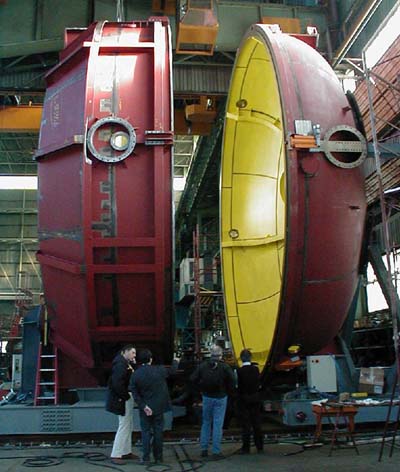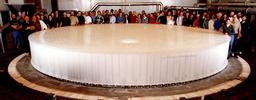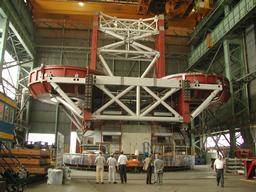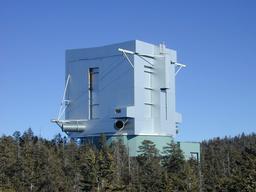Telescope Mirror to Get Shiny Finish in Major Test Run
by Pam Frost Gorder of Ohio State University
More articles in Telescopes COLUMBUS, Ohio - In an airplane hangar in Columbus, OH, some 80 tons of steel, electronics, and cryogenic equipment are about to come together -- all to deposit one ounce of aluminum as a near-perfect, whisper-thin coating on a giant telescope mirror.
COLUMBUS, Ohio - In an airplane hangar in Columbus, OH, some 80 tons of steel, electronics, and cryogenic equipment are about to come together -- all to deposit one ounce of aluminum as a near-perfect, whisper-thin coating on a giant telescope mirror.The successful operation of the coating system will represent a milestone in the construction of the Large Binocular Telescope (LBT), and a critical phase in Ohio State University's participation in the LBT project.
In 2004, when construction is to be completed on Mt. Graham in Arizona, the LBT will be the worlds largest optical and infrared telescope. Before that can happen, Ohio State research scientist Bruce Atwood and his colleagues will have to perfect the process for covering the LBTs primary mirrors with a reflective coating of aluminum.
 LBT Primary Mirror: The first 8.3 meter mirror and the team who cast it at the Steward Observatory Mirror Laboratory beneath the University of Arizona football stadium. Photo Credit: Lori Stiles and John Florence (University of Arizona).
LBT Primary Mirror: The first 8.3 meter mirror and the team who cast it at the Steward Observatory Mirror Laboratory beneath the University of Arizona football stadium. Photo Credit: Lori Stiles and John Florence (University of Arizona).In a 9.1-meter (30-foot) diameter steel cell, an 8.4-meter (28-foot) sample, or dummy, mirror will simulate one of the LBT mirrors.
On November 26, the cell will seal against a similarly sized lid, called a bell jar, to create a clean, high-vacuum environment for coating.
Atwood explained that the coating would be an essential part of the LBT. The telescopes concrete foundation, the support structure, the glass mirrors -- the entire LBT building -- is being made just to support this thin coating of reflective aluminum. Without it, the telescope cant see, he said.
The coating project improves on existing technology. Engineers have created vacuums in similar bell jars to test the space-worthiness of satellites, and have been coating smaller telescope mirrors inside such vessels for more than 50 years.
To meet the challenge of scaling up the technology for very large mirrors, Atwood and his team have had to devise new ways to create the vacuum and assure a very uniform film.
Our expertise is working the kinks out of the procedure so it can be repeated on the final LBT mirrors on Mt. Graham in 2004, Atwood said.
Atwoods team includes research scientists Paul Byard, Tom O'Brien, Ralph Belville, Dave Brewer, David Steinbrecher, Dan Pappalardo, Jerry Mason, and Ed Teiga, all of the Imaging Sciences Laboratory in Ohio States Department of Astronomy.
 Telescope Structure. Built by Ansaldo-Camozzi Energy Special Components in Milan, Italy, the structure that will hold the mirrors for the Large Binocular Telescope was completed in November, 2001. The structure has been shipped to Mt. Graham and is currently in the process of being moved up the mountain. Photo Credit: Patrick Osmer (OSU)
Telescope Structure. Built by Ansaldo-Camozzi Energy Special Components in Milan, Italy, the structure that will hold the mirrors for the Large Binocular Telescope was completed in November, 2001. The structure has been shipped to Mt. Graham and is currently in the process of being moved up the mountain. Photo Credit: Patrick Osmer (OSU)After Atwood supervised initial tests of the bell jar and cell in Italy, LBT scientists took apart the equipment and shipped it to Rickenbacker International Airport, formerly Rickenbacker Air Force Base, in Columbus, OH. Ohio State rented a hangar at the airport to house the heavy parts, which arrived in several crates, each the size of a small house.
Cranes will soon place the 44-ton mirror cell and 22-ton bell jar onto wide-set train rails.
We have one of the widest, shortest, and slowest railroads in America, joked Atwood.
On November 20, a carriage will bring the two massive parts together at a slow 10 inches per minute, so the scientists can assure a precise connection.
Together, the equipment will form a fat disk that resembles an oversized diving bell tipped on its side.
Once the bell jar and dummy mirror cell are sealed, mechanical vacuum pumps will siphon away most of the air inside; all but a tiny fraction of one percent will remain. Then the Ohio State scientists will employ a special cryogenic system they designed in which extremely cold charcoal will absorb almost all the remaining air molecules.
After the vacuum is established, the scientists will super-heat an array of 25 crucibles, each containing a quarter of an ounce of aluminum. The aluminum will melt, then boil inside the chamber. Just as steam escapes from a boiling pot and condenses as water on the lid, some of the evaporated aluminum will float through the chamber and condense on the surface of the mirror. Molecules of a scattering gas will spread the molecules of gaseous aluminum so they deposit evenly.
If all goes well, the aluminum will cool to form a smooth, uniform coating, with no bumps or bare spots to spoil the mirrors reflection.
 LBT Enclosure. Completed in June 2002, the building that encloses the LBT sits atop Mt. Graham, 10,298 feet above sea level. The enclosure is 50 meters high and the rotating part weighs 1250 tons.Photo Credit: John Hill (UA/Steward Observatory)
LBT Enclosure. Completed in June 2002, the building that encloses the LBT sits atop Mt. Graham, 10,298 feet above sea level. The enclosure is 50 meters high and the rotating part weighs 1250 tons.Photo Credit: John Hill (UA/Steward Observatory)Then the Ohio State scientists will dismantle the equipment once again, and ship it by truck and barge to Mt. Graham, where coating of the final telescope mirrors will take place.
The LBTs mirrors will belong to a new generation of telescopes designed to produce sharper images through adaptive and active optics. Computer-controlled pistons will adjust the shape of smaller secondary mirrors, to help astronomers see through turbulent gas in Earths atmosphere that would blur the view of distant stars and galaxies.
With its giant mirrors, the $100 million LBT is to have 25 times the light-collecting area and 10 times the image resolution of the Hubble Space Telescope. Through financial and in-kind contributions, Ohio State holds a one-eighth share of the cost of the LBT project. One such in-kind contribution comes form perfecting the aluminization process, for which Ohio State will earn $1 million worth of observing time on the LBT -- the equivalent of about 20 nights.
Other partners in the LBT project include the University of Arizona, with participation form Arizona State University and Northern Arizona University; a group of Italian observatories led by the Arcetri Astrophysical Observatory in Florence; and a group of German institutes and observatories led by the Max Planck Institute for Astronomy in Heidelberg -- each of which hold a one-fourth share of the project. The Research Corporation, a private foundation in Tucson, Arizona, holds the remaining one-eighth share, and has given portions of its observing time to Ohio State, the University of Notre Dame, the University of Virginia, and the University of Minnesota.
With its grant from the Research Corporation, Ohio State will actually enjoy a total of one-sixth of the available observing time on the telescope.